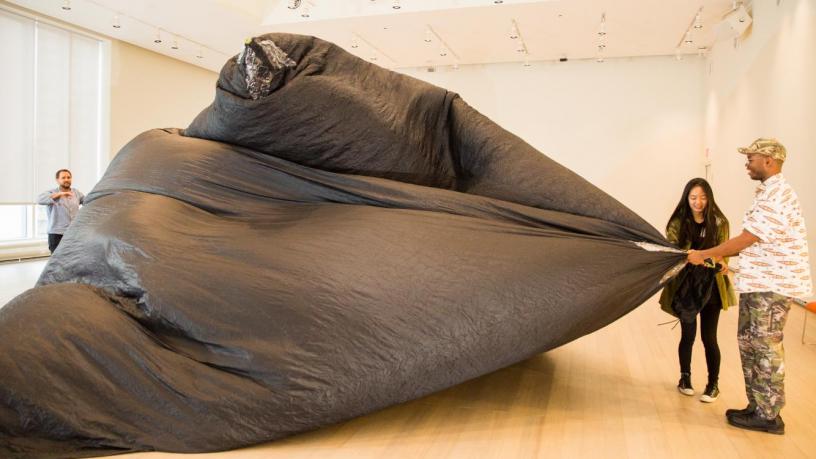Heading for the Clouds: Artist Tomás Saraceno envisions the “Aerocene” Age
We humans are all “living at the bottom of an ocean of air,” says the multidisciplinary artist and innovator Tomás Saraceno, so why shouldn’t we float in the sky as marine creatures do in water?

Lillian Zha '20 and a fellow student with the Aerocene, a flying sculpture designed by the artist Tomas Saraceno.
The Argentinean-born visionary—whose work inventively combines art, science and engineering to profoundly explore our relationship to the environment—recently brought this lofty vision to Columbia for an October residency in a joint initiative co-hosted by the School of Engineering and Applied Science, the School of the Arts, and the School of International and Public Affairs. Incorporating a student workshop and a series of lab visits, the residency also included a public talk at the new Lenfest Center for the Arts, where Saraceno spoke about the radically sustainable future he hopes to help usher in. Dubbed the “aerocene” age, Saraceno imagines a new era in which we are all acutely sensitive to social connections and effortlessly in tune with natural rhythms.
At this presentation, Saraceno described one of his most well-known works, the Aerocene D-O AEC, an air-fueled sculpture that doubles as the world’s first entirely aerosolar vehicle. A striking, balloon-like structure fashioned from gigantic sheets of recycled plastic bags, it takes off in the absence of any motor and without the use of any fuel, driven only the heat of the sun and infrared radiation rising from the ground—an experience designed to provoke major shifts in perspective.
“I had always dreamed of floating among the clouds,” said Saraceno, whose work has been exhibited at the Museum of Modern Art, the Natural History Museum of London, MIT, and numerous other institutions.
Realizing that dream involves engineering feats as well artistic ones. Saraceno and associates have successfully climbed aboard the Aerocene for hours-long flights, drifting according to shifting atmospheric conditions. He is currently working on an app that predicts flight paths, calculating the best times and altitudes to reach desired destinations.
By making the Aerocene project open source, Saraceno hopes to encourage others to reach for the skies, eventually giving birth to large floating ecosystems. Such a prospect would require a new way of thinking about the legal frameworks that divvy up global airspace, as the sculptures can easily transgress national borders, as well as the responsibility to peacefully share that space with other species.
“I try to encourage people to think differently about how we’ve been inhabiting the air,” Saraceno said.
